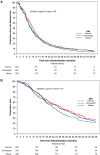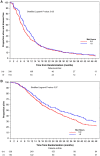Physical Activity, Weight, and Outcomes in Patients Receiving Chemotherapy for Metastatic Breast Cancer (C40502/Alliance)
- PMID: 33981951
- PMCID: PMC8103727
- DOI: 10.1093/jncics/pkab025
Physical Activity, Weight, and Outcomes in Patients Receiving Chemotherapy for Metastatic Breast Cancer (C40502/Alliance)
Abstract
Background: Obesity and inactivity are associated with increased risk of cancer-related and overall mortality in breast cancer, but there are few data in metastatic disease.
Methods: Cancer and Leukemia Group B 40502 was a randomized trial of first-line taxane-based chemotherapy for patients with metastatic breast cancer. Height and weight were collected at enrollment. After 299 patients enrolled, the study was amended to assess recreational physical activity (PA) at enrollment using the Nurses' Health Study Exercise Questionnaire. Associations with progression-free survival (PFS) and overall survival (OS) were evaluated using stratified Cox modeling (strata included hormone receptor status, prior taxane, bevacizumab use, and treatment arm). All statistical tests were 2-sided.
Results: A total of 799 patients were enrolled, and at the time of data lock, median follow-up was 60 months. At enrollment, median age was 56.7 years, 73.1% of participants had hormone receptor-positive cancers, 42.6% had obesity, and 47.6% engaged in less than 3 metabolic equivalents of task (MET) hours of PA per week (<1 hour of moderate PA). Neither baseline body mass index nor PA was statistically significantly associated with PFS or OS, although there was a marginally statistically significant increase in PFS (hazard ratio = 0.83, 95% confidence interval = 0.79 to 1.02; P = .08) and OS (hazard ratio = 0.81, 95% confidence interval = 0.65 to 1.02; P = .07) in patients who reported PA greater than 9 MET hours per week vs 0-9 MET hours per week.
Conclusions: In a trial of first-line chemotherapy for metastatic breast cancer, rates of obesity and inactivity were high. There was no statistically significant relationship between body mass index and outcomes. More information is needed regarding the relationship between PA and outcomes.
© The Author(s) 2021. Published by Oxford University Press.
Figures




References
-
- Protani M, Coory M, Martin JH.. Effect of obesity on survival of women with breast cancer: systematic review and meta-analysis. Breast Cancer Res Treat. 2010;123(3):627–635. - PubMed
-
- Chlebowski R, Aiello E, McTiernan A.. Weight loss in breast cancer patient management. J Clin Oncol. 2002;20(4):1128–1143. - PubMed
-
- Goodwin P. Energy balance and cancer prognosis: breast cancer. In: McTiernan A, ed. Cancer Prevention and Management through Exercise and Weight Control. Boca Raton, FL: Taylor and Francis Group; 2006:405–435.
-
- Niraula S, Ocana A, Ennis M, Goodwin PJ.. Body size and breast cancer prognosis in relation to hormone receptor and menopausal status: a meta-analysis. Breast Cancer Res Treat. 2012;134(2):769–781. - PubMed
Publication types
MeSH terms
Substances
Grants and funding
LinkOut - more resources
Full Text Sources
Other Literature Sources
Medical
Miscellaneous
